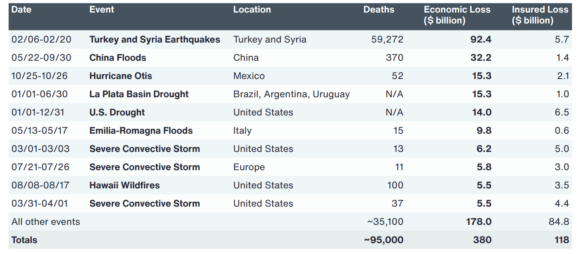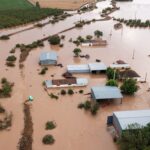Global insured losses from natural catastrophes totaled $118 billion in 2023, according to Aon’s annual Climate and Catastrophe Insight report. That number represented 31 percent of the total economic loss caused by 398 global natural disaster events.
While 2022 saw the lowest global protection gap on record, that gap returned to “average levels in 2023,” Aon reported. Still, significant regional differences remained. Most disaster losses were covered in the United States, the report said, but most losses in EMEA, APAC and Americas remained uninsured.
Fast facts:
According to Aon’s report, 66 billion-dollar economic loss events recorded in 2023 were the highest number on record, towering above the average of 42.
Forty-three of them were weather events.
Only 40 percent of the weather and climate-related events were covered by insurance.
“This shows that closing the protection gap will continue to pose a challenge but also a huge opportunity for certain regions,” the report said.
Aon reported that the protection gap is a critical reference point for the insurance industry, financial markets and governments, as it illustrates the financial vulnerability of communities and provides an opportunity to identify the need for new solutions.
Overall global economic losses from natural disasters hit $380 billion last year, up from $355 billion in 2022. Aon reports that the above-average losses in 2023 were driven by “significant earthquakes and relentless severe convective storms in the United States and Europe.”
“U.S. drought and the earthquake sequence in Turkey and Syria were the costliest events for insurance, considering both public and private entities,” according to the report. “While no event reached the 10-billion-dollar mark, there were at least 37 billion-dollar (insured) disasters in total, marking a new historical record.”

Aon reported that this underlines the growing frequency of medium-sized events — particularly severe convective storms — and their impact on global losses, noting that severe convective storms were the most damaging peril for insurers.
“The findings of the report highlight the need for organizations — from insurers to highly impacted sectors such as construction, agriculture and real estate — to utilize forward-looking diagnostics to help analyze climate trends and mitigate the risk, as well as protecting their own workforces,” Andy Marcell, CEO of Risk Capital and CEO of Reinsurance at Aon, said in a press release.
He continued: “Risk managers can take advantage of increasingly sophisticated tools and leverage analytics to unlock capital and make better decisions. Equally, the insurance industry plays a critical role in improving the financial resilience of communities within their portfolios and taking the opportunity to bridge the protection gap with new and relevant products.”
The report also shared that, worldwide, 95,000 people died due to natural hazards in 2023. This marked the highest number of deaths since 2010. Aon reported that in terms of climate, 2023 was the hottest year on record, with all-time highs observed in 24 countries and territories.
“Amidst increasing volatility and complexity, there is a significant opportunity for organizations to become more resilient to the climate and catastrophe risks highlighted in our report,” Greg Case, CEO of Aon, said in a press release. “By working across the private and public sector we are accelerating innovation, protecting underserved communities and better addressing the economic impacts of extreme weather to create more sustainable outcomes for businesses and communities around the world.”





















 Is the AI Boom a Bubble Waiting to Pop? Here’s What History Says
Is the AI Boom a Bubble Waiting to Pop? Here’s What History Says  Surge of Supercharged Hurricanes Prompt Call for Cat 6 Classification
Surge of Supercharged Hurricanes Prompt Call for Cat 6 Classification  Slideshow: Carrier Management’s 2025 Top Editor’s Picks (Unlocked)
Slideshow: Carrier Management’s 2025 Top Editor’s Picks (Unlocked)  Good Times for U.S. P/C Insurers May Not Last; Auto Challenges Ahead
Good Times for U.S. P/C Insurers May Not Last; Auto Challenges Ahead 





